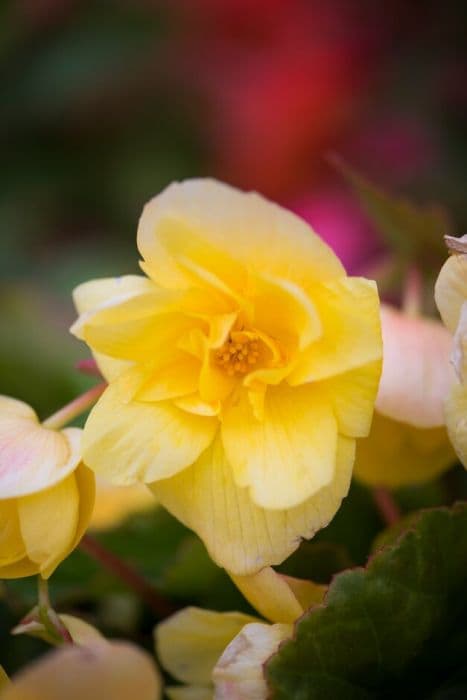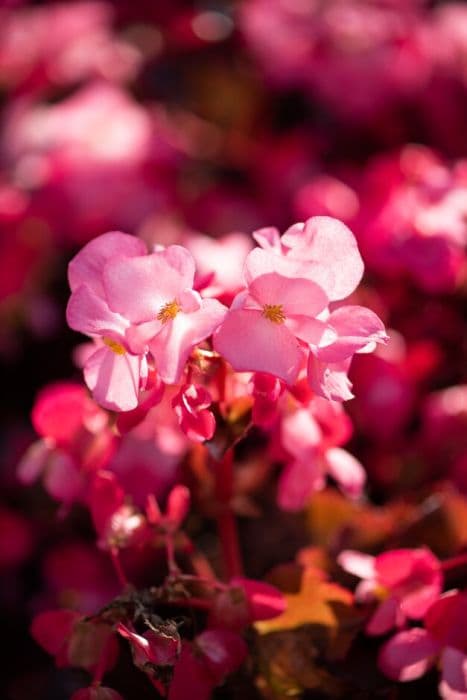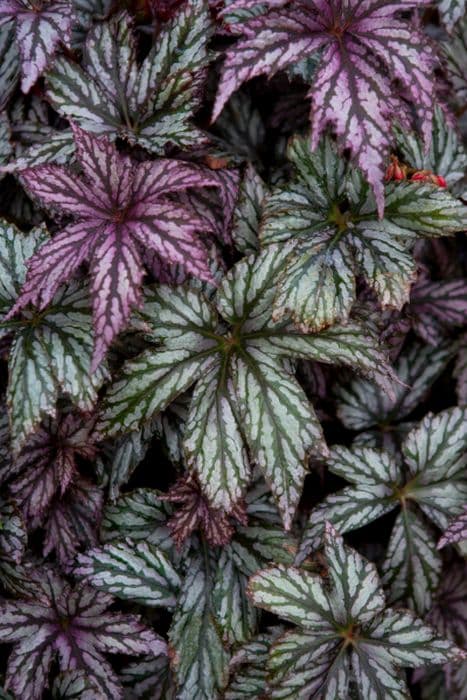Begonia Begonia Devotion = 'Yadev' (Million Kisses Series)
![begonia [Devotion]](/_next/image?url=https%3A%2F%2Fplants-admin.emdemapps.com%2Fimages%2Fplants%2F%2Fimages%2F604b58183573b.png&w=3840&q=75)
ABOUT
The Begonia Devotion, which is part of the Million Kisses Series, boasts a striking appearance characterized by its vibrant foliage and abundant floral display. The plant's leaves are typically glossy with a succulent texture, showcasing a deep green color that can form a lush backdrop for its blossoms. These leaves may occasionally present with subtle variegation or interesting patterns, enhancing the plant's ornamental appeal. The real standouts, however, are the flowers. The Begonia Devotion is celebrated for its profusion of blooms that appear tirelessly throughout the growing season. The flowers exhibit a vivid hue, often a deep, passionate red or a similar shade that embodies the sense of devotion expressed in the plant's name. These blooms are pendulous, hanging in a cascading manner that adds a sense of movement and dynamism to the plant's overall shape. The plant's growth habit is such that it often spills generously over the edges of containers or baskets, making it a favorite for hanging displays where its trailing stems and lush flowers can be showcased gracefully. Its blossoming habit and the color of its blooms make it a visually appealing choice for adding a pop of color to any setting. The texture and density of its foliage, combined with the prolific flowering, ensure that the Begonia Devotion remains a centerpiece in gardens and indoor environments alike, without the need to reference its size.
About this plant
 Names
NamesFamily
Begoniaceae
Synonyms
Begonia 'Devotion', Million Kisses Devotion
Common names
Begonia 'Yadev'
 Toxicity
ToxicityTo humans
Begonias, including the Begonia Devotion, are considered mildly toxic to humans. If ingested, they can cause irritation of the mouth, lips, and throat due to the presence of insoluble oxalates. In some cases, ingestion may also lead to nausea, vomiting, and diarrhea. These symptoms are typically not severe, but it's essential to keep begonias out of the reach of children who might be tempted to chew on the leaves or stems.
To pets
Begonias, such as the Begonia Devotion, are toxic to pets. If pets consume any part of the plant, they can experience symptoms like drooling, vomiting, and difficulty swallowing due to the insoluble oxalates present in the plant. In severe cases, ingestion can lead to kidney failure in pets like cats and dogs. It is important to prevent your pets from chewing on or ingesting this plant to avoid these potentially harmful effects.
 Characteristics
CharacteristicsLife cycle
Perennials
Foliage type
Evergreen
Color of leaves
Varies
Flower color
Varies
Height
1 feet (0.3 meters)
Spread
1 feet (0.3 meters)
Plant type
Herb
Hardiness zones
10
Native area
Tropical South America
Benefits
 General Benefits
General Benefits- Easy to grow - Begonia Devotion requires minimal maintenance, making it suitable for gardeners of all skill levels.
- Long blooming period - It typically has a lengthy flowering season, offering prolonged visual appeal.
- Versatile - This plant is suitable for containers, hanging baskets, and as bedding plants, offering flexibility in garden design.
- Attracts pollinators - The flowers can attract beneficial insects like butterflies, aiding in the pollination of your garden.
- Colorful foliage - The leaves can add an additional layer of color and texture to garden spaces even when the plant is not in bloom.
- Drought-tolerant - Once established, it can handle periods of dryness, reducing the need for constant watering.
- Compact growth - Its growth habit makes it ideal for areas where space is at a premium or for adding fullness to mixed plantings.
 Medical Properties
Medical PropertiesThis plant is not used for medical purposes.
 Air-purifying Qualities
Air-purifying QualitiesThis plant is not specifically known for air purifying qualities.
 Other Uses
Other Uses- Artistic Inspiration: Begonias, with their diverse colors and forms, can serve as a muse for artists and crafters, inspiring paintings, sculptures, and textile patterns.
- Edible Decorations: Some species of begonias have edible flowers that can be used to embellish salads or desserts, adding a touch of elegance and color.
- Photography Subjects: Thanks to their vibrant colors and interesting shapes, begonias are perfect subjects for photographers looking to capture the beauty of nature.
- Educational Model: Begonias can be used in biology classes to teach students about plant structure, hybridization, and propagation techniques.
- Festive Garlands: The colorful begonia blooms can be strung together to create festive garlands for celebrations and decorative purposes.
- Theme Gardens: Begonias can be a central theme for a garden, showcasing the genus' diversity by creating a collection solely of Begonia variants.
- Color Therapy: Their vibrant hues can be used in color therapy to elevate mood and create a calming environment, reflecting the emotional impact of different colors.
- Living Jewelry: Small begonia plants or flowers can be incorporated into living jewelry designs, such as pendants or earrings, for a unique botanical accessory.
- Natural Confetti: Dried begonia petals can serve as an eco-friendly confetti alternative for celebrations, decomposing naturally without harming the environment.
- Culinary Experiments: The subtle flavors of certain edible begonia varieties can be tested in culinary experimentation to develop new dishes and flavor combinations.
Interesting Facts
 Feng Shui
Feng ShuiThe Begonia is not traditionally associated with Feng Shui practice.
 Zodiac Sign Compitability
Zodiac Sign CompitabilityThe Begonia is not used in astrology practice.
 Plant Symbolism
Plant Symbolism- Caution: Begonias are generally associated with warnings or alerts to be careful. This symbolism comes from the plant's delicate nature and the need for care when handling it to avoid damage or disease.
- Beware: Similar to the symbol of caution, begonias can also signify to beware of your actions or the situations around you. It's a reminder to be vigilant about potential problems or pitfalls.
- Gratitude: Gifting begonias often represents a feeling of thankfulness towards someone. They can be used to express appreciation for help or kindness received.
- Uniqueness: With their wide variety of colors and patterns, begonias can symbolize individuality and standing out from the crowd. They encourage embracing one's unique qualities.
- Harmony: The balance between the begonia's need for sunlight and shade can signify a sense of harmony and balance in life. They remind us to find a peaceful equilibrium in our daily affairs.
 Water
WaterFor the Begonia 'Million Kisses Devotion', it's crucial to maintain a balance in watering; the soil should be kept evenly moist but not waterlogged. Typically, watering once a week should suffice, but this may vary depending on temperature and humidity. During hot weather, check the soil moisture more frequently and you might need to water up to twice a week. It’s best to use around 16 to 24 ounces of water for a medium-sized pot during each watering session, ensuring that excess water can freely drain out to prevent root rot.
 Light
LightThe Begonia 'Million Kisses Devotion' thrives in bright, indirect sunlight. It should be placed in a location that receives plenty of light but is shielded from the harsh rays of the afternoon sun. A spot near an east or west-facing window is ideal, where it can enjoy gentle morning or late afternoon sun without the risk of scorching.
 Temperature
TemperatureBegonia 'Million Kisses Devotion' prefers a temperature range of 60 to 75 degrees Fahrenheit for optimal growth. It can survive a minimum temperature of around 50 degrees Fahrenheit but should be protected from cold drafts and frost. The ideal climate for this begonia is a warm, humid environment that avoids the temperature extremes of below 50 and above 86 degrees Fahrenheit.
 Pruning
PruningPruning the Begonia 'Million Kisses Devotion' encourages bushier growth and more blooms. Prune or pinch back the stems by removing the tips, which can be done every few weeks during the active growing season. The best time to prune heavily is in early spring to prepare for new growth, removing any dead or damaged stems to maintain plant health.
 Cleaning
CleaningAs needed
 Soil
SoilThe best soil mix for Begonia Devotion ('Yadev') is a well-draining, peat-based potting mix with added perlite or vermiculite to enhance aeration. The ideal pH level for this plant is between 5.5 and 6.5.
 Repotting
RepottingBegonia Devotion ('Yadev') should be repotted every 1-2 years, or when it becomes root-bound in its pot, to ensure continued growth and health.
 Humidity & Misting
Humidity & MistingBegonia Devotion ('Yadev') thrives in high humidity conditions, ideally between 50-70%. Avoid excessively dry air to maintain the plant's health.
 Suitable locations
Suitable locationsIndoor
Place in bright, indirect light with high humidity.
Outdoor
Provide shade, protect from intense sun and frost.
Hardiness zone
10-11 USDA
 Life cycle
Life cycleThe Begonia Devotion, part of the Million Kisses Series, starts its life cycle as a seed, which germinates when exposed to warm temperatures and sufficient moisture. After germination, it enters the seedling stage where the first true leaves develop, requiring plenty of light and water to establish a healthy root system. As it matures, the plant enters the vegetative stage, producing robust foliage and stems, and should be pruned to encourage bushier growth. Following the vegetative phase, the Begonia Devotion enters the flowering stage, producing vibrant blooms that attract pollinators and may last for an extended period of time if deadheaded regularly. Post-blooming, if the flowers are left to set seed, the plant may produce viable seeds that can be collected and sowed to start new plants. At the end of its life cycle, the plant will naturally begin to decline, at which point it can be composted or, if it is a perennial in its growing zone, it may enter a period of dormancy before regrowing the following season.
 Propogation
PropogationPropogation time
Spring to Summer
The Begonia Devotion, commonly known as part of the Million Kisses series, is typically propagated through stem cuttings, which is the most popular method due to its ease and effectiveness. The best time to take stem cuttings is during the growing season, which is spring through early fall. To propagate, select a healthy stem with at least a couple of leaves and make a clean cut just below a node, where the leaf meets the stem. The cut should be about 3-4 inches long (approximately 7.5-10 centimeters). Remove the bottom leaves, and then dip the cut end in rooting hormone before inserting it into a pot filled with a well-draining soil mix. Keep the soil consistently moist but not waterlogged, and place the pot in a warm spot with indirect sunlight. Roots typically develop within a few weeks, after which you can transplant the cutting to a larger pot or into the garden.









![Begonia [Fragrant Falls Orange]](/_next/image?url=https%3A%2F%2Fplants-admin.emdemapps.com%2Fimages%2Fplants%2F%2Fimages%2F604b537c1a26c.png&w=640&q=75)